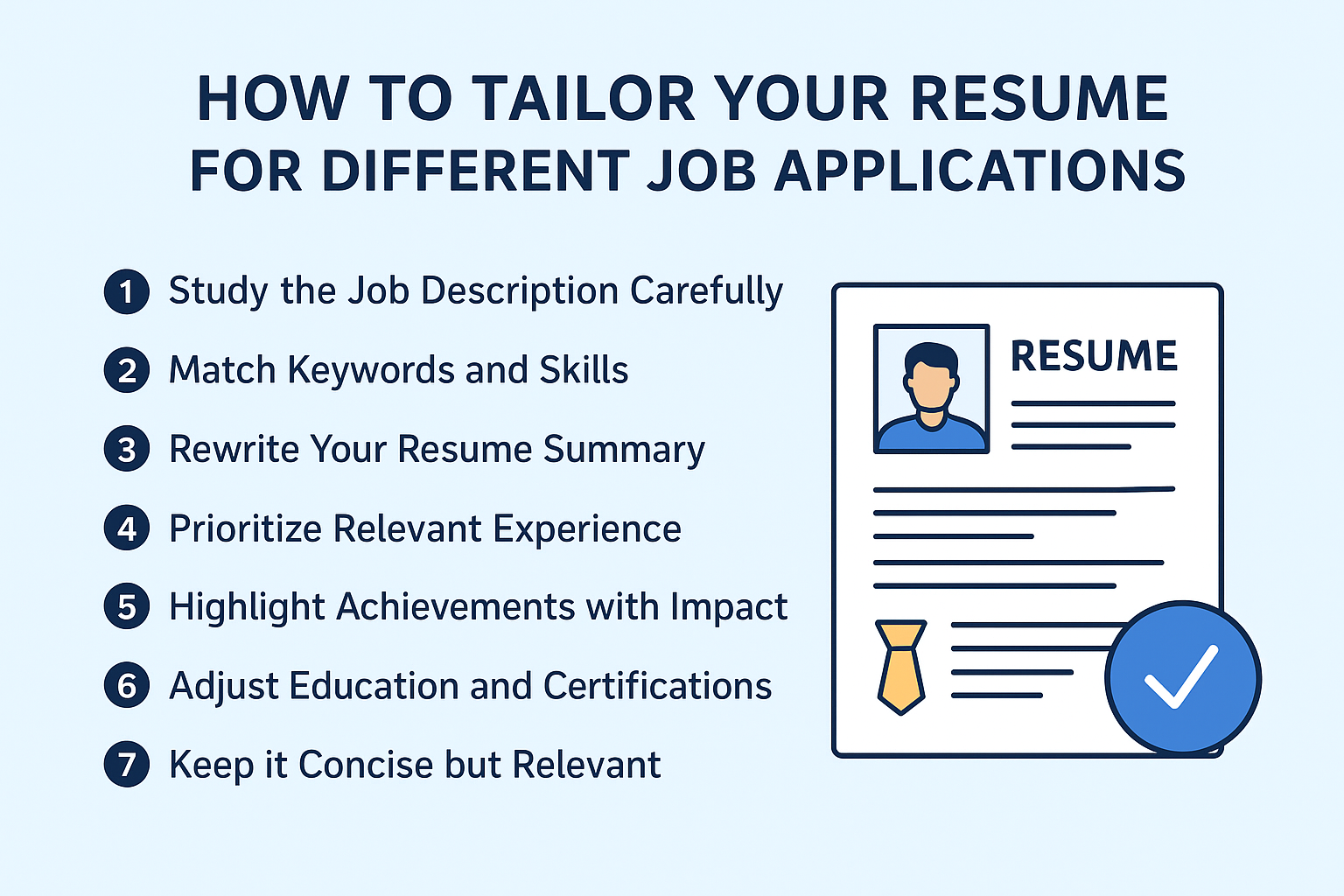Tailoring Your Resume for Different Job Applications (Step-by-Step Guide)
When applying for jobs, one of the biggest mistakes candidates make is sending the same generic resume to multiple employers. Recruiters can easily spot a one-size-fits-all document, and in today’s competitive job market, that won’t get you far. The key to standing out is tailoring your resume for different job applications.
In this post, we’ll walk you through why tailoring matters, step-by-step instructions to do it effectively, and examples to guide you.

Why Tailoring Your Resume Matters
A tailored resume shows the employer that:
- You understand the role and the company’s needs.
- You’ve taken the time to align your experience with their expectations.
- You’re not just looking for any job; you’re genuinely interested in their position.
Recruiters often use Applicant Tracking Systems (ATS) to filter resumes. By including the right keywords from the job description, you increase your chances of making it past the initial screening.
Step-by-Step Guide to Tailoring Your Resume
1. Study the Job Description Carefully
Print it out or highlight it on your screen. Pay attention to:
- Required skills (hard and soft skills).
- Responsibilities are mentioned multiple times.
- Keywords and industry-specific terms.
👉 Example: If the job description says, “Must have experience with CRM tools like Salesforce,” make sure you list your Salesforce experience.
2. Match Keywords and Skills
ATS systems scan for exact matches. Replace generic phrases with the employer’s wording.
- Instead of “customer relationship software,” write “CRM (Salesforce).”
- Instead of “team leader,” use “project manager” if that’s what the posting emphasizes.
3. Rewrite Your Resume Summary
Your professional summary should directly reflect the job you’re applying for.
- Generic summary: “Experienced customer service professional skilled in problem-solving.”
- Tailored summary: “Customer service specialist with 4+ years of experience using Salesforce to manage client accounts and resolve escalated issues in a fast-paced fintech environment.”
4. Prioritize Relevant Experience
Not every past role will be equally relevant. Highlight the duties and achievements that align with the current opening.
- If applying for a logistics role, emphasize shipment coordination, vendor management, and documentation.
- If applying for a sales role, highlight revenue growth, client acquisition, and pitching success.
5. Highlight Achievements with Impact
Employers want results, not just responsibilities. Use measurable outcomes.
- Instead of: “Handled customer complaints.”
- Write: “Resolved 50+ customer complaints weekly, increasing satisfaction scores by 20%.”
6. Adjust Education and Certifications
If you have certifications or coursework directly relevant to the role, move them higher up on your resume. For instance:
- Applying for data analysis → Feature your Excel, SQL, or Tableau certifications prominently.
- Applying for teaching/education → Showcase your training, teaching license, or volunteer programs.
7. Keep it Concise but Relevant
Don’t overload your resume with irrelevant details. A concise, focused resume that demonstrates alignment with the job description will be more effective than a long one filled with unrelated information.
Example of Tailoring in Action
Job Posting (snippet):
“Looking for a marketing coordinator with experience in social media campaigns, content writing, and analytics tools like Google Analytics.”
Generic Resume Line:
“Worked on company social media and content projects.”
Tailored Resume Line:
“Coordinated and executed social media campaigns across Instagram and LinkedIn, created SEO-optimized blog content, and tracked campaign performance using Google Analytics to boost engagement by 35%.”
Common Mistakes to Avoid When Tailoring Your Resume
- Copy-pasting the job description. ATS may catch keywords, but recruiters will notice the lack of originality.
- Overstuffing with keywords. Use them naturally; don’t force.
- Ignoring soft skills. Employers also look for qualities like leadership, communication, and teamwork.
Final Thoughts
Tailoring your resume might take extra time for each application, but the results are worth it. Instead of sending out dozens of generic resumes with little response, a tailored resume increases your chances of getting interviews faster.
Think of it this way: your resume is not just a list of your work history, it’s your personal marketing document. Each version should be crafted to convince one specific employer that you’re the right fit.
Take the extra 15–20 minutes to align your resume with the job description, and you’ll see a significant difference in your job search success.
